Earlier this week, our comrade and fellow writer Summer interviewed Mugginns and I for a Meet the Team: Historicals article. Not one to pass up any opportunity for self promotion, I immediately checked the comments – and one suggested (thanks Gareth!) that we try out some Wargaming Board games for Goonhammer Historicals. So here we are doing it – your comments really do matter to us!
I came into historical miniature wargaming through Warhammer and Games Workshop, so the vast and esoteric world of wargaming without miniatures – board games, map games, hex and chit games, counter games and even journaling games – is a bit of a mystery to me. But, a couple of weeks ago I had a kid and it’s pretty clear that I need my Historicals fix to not involve 200+ French Line Infantry, a bevy of metal Saxons or the Perry foot knight kit, if only because all of that requires a huge amount of time to get out, play with and put away. Time that now vanishes into the ever-hungry maw of my son – but time that might be well spent with Board based wargaming.
The only board wargame I have is Ottoman Sunset by Victory Point Games and, between feeds, nappy changes and wondering if I’ll ever sleep again, I’ve been exhaustively putting it through it’s paces.
Ottoman Sunset
Ottoman Sunset is a solitaire (single player) board game recreating the First World War from the Ottoman perspective. You play as the Ottoman Triumvirate, attempting to fight a war on several fronts, assist your Austro-Hungarian and German allies, disturb British Colonialism and generally make it through 1914-1918 in one piece, despite the fact you could easily have sat out of it altogether. It’s firmly strategic in scale, with entire fronts abstracted out to a single counter, which is very much unfamiliar territory for a wargamer! It’s one of a series of games called “States of Siege” and that’s very much the vibe here as you marshal incredibly tight resources, prioritise attacks and effort and try to cope with the progress of the war around the world.
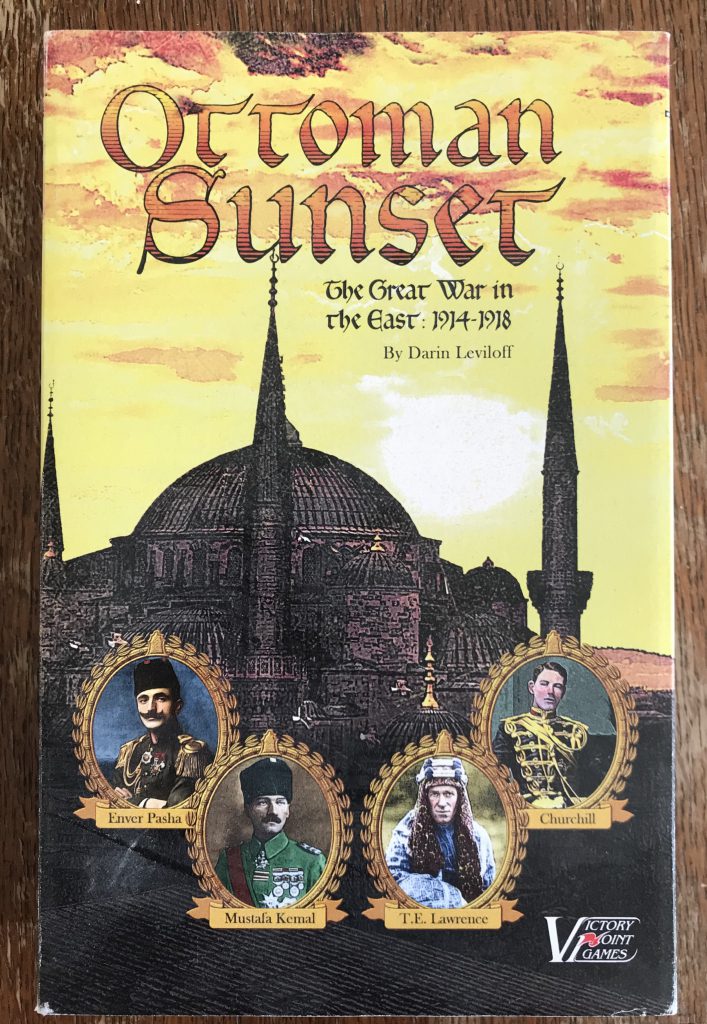
All of that comes in a tiny little box – a very nice thick cardboard board, high quality chits and pieces, beautifully printed and bound rulebook and one scarily small dice. As a wargamer the dice gave me a nice familiar feeling – combat and events in this game are resolved via simple d6 rolls. There’s a massive advantage to this self contained approach – when was the last time that you, oh great and wise historicals reader, managed to sit down with everything that you needed for a wargame in something smaller than a shoebox and had a really satisfying time with just the box!

How does it work?
As you control the entire Ottoman war effort, you’re fighting against Russians in the Caucuses, the British in the Levant and eventually ANZACs in the Dardanelles and Franco-British in Greece and Macedonia. These fronts are represented by tracks that your enemy armies progress along – if they get to Istanbul, it’s game over. You, as the Triumverate, have a limited number of attacks along these fronts, your only way to hold back the tide – but you won’t be able to attack on every front every turn, so careful choices and last-gasp efforts are very much the order of the day.
The game progresses through a deck of event cards that represent the ongoing war – the cards describe real historical events, and associate these with gameplay mechanics. Each turn is a card draw that describes a historical event, grants actions and tells you which of your threatening fronts advance. A big Russian offensive may push the Caucus front forward, but grant you a respite on the Levantine front. These cards correspond to real strategic initiatives during the war, and tie your Ottoman game into the wider war. The events are rarely good, and you’ll always be scrambling for breathing room and throwing your resources down to cope with threats both immediate and in the future. There’s a good wrinkle in the way the deck works – you can divide them into the three phases of the war the game works with and shuffle them, providing a little randomness, or order them chronologically, allowing you to fight right through the war “historically”.
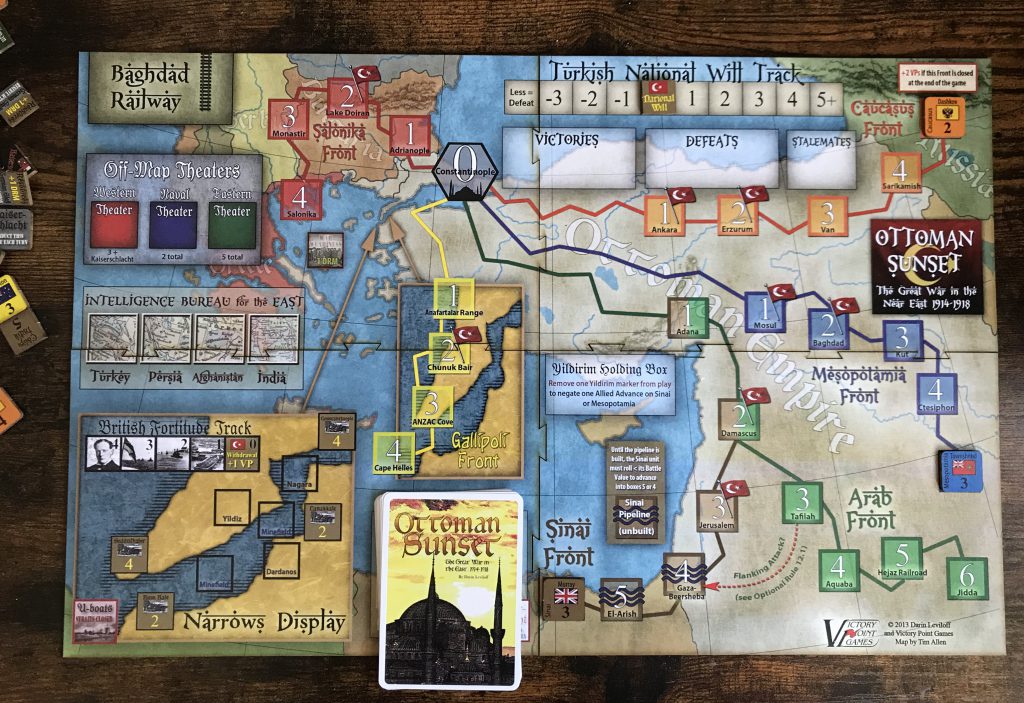
While D6 combat resolution is the bread and butter of the game, you’re not wholly at the mercy of dice – you have resources you can invest, representing both time and material investment in defences, getting your best generals in the right places at the right times and occasional rare support from Germany and Austria. These resources really matter and end up being incredibly precious – holding on to them for the perfect time might be tempting, but miss your opportunity when you really need it and it might be far too late.
What’s good about it?
Aside from the fact that it packs away nicely and conveniently, there’s a lot of good about Ottoman Sunset. It’s a tense, edge of your seat experience and the first few games I played I got absolutely and completely destroyed – but that’s the point! The Ottoman war experience was extremely dicey, an agricultural nation fighting an industrial war on multiple fronts. Defence and resource allocation was the order of the day. There’s an important caveat to this that the game doesn’t deal with (and I’ll talk about later), but the siege tracker system feels like a very good way of arriving at an abstract, simplified analogy of the historical experience of the Ottoman war.
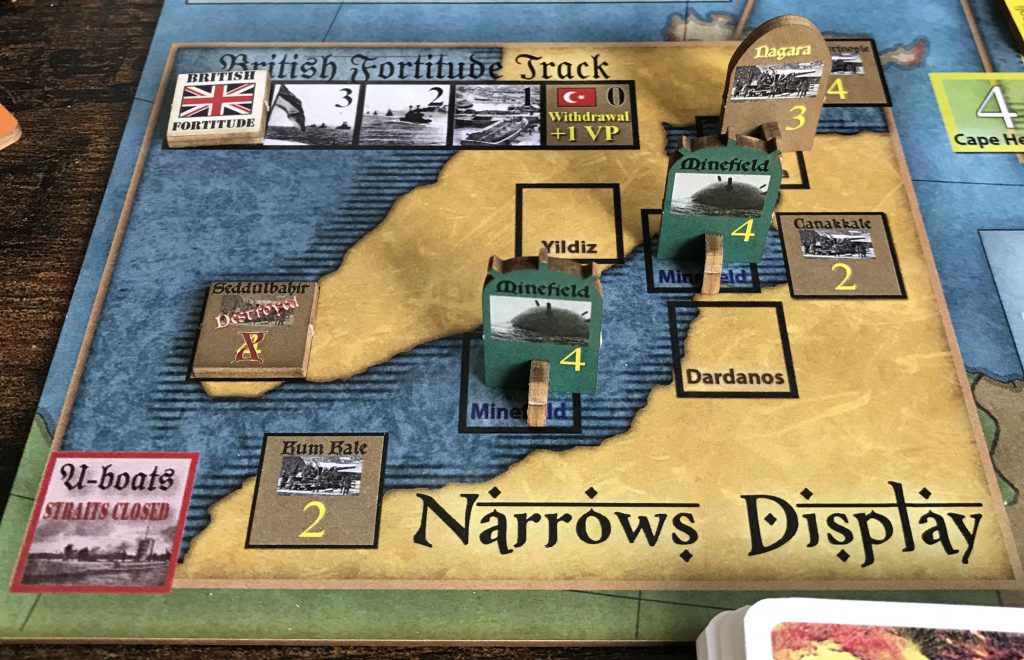
The dice and resource system supports working through this kind of dicey experience, and makes every turn/reveal of an event guard impactful and important. You very, very rarely get a turn when you’re able to sit on your laurels and you always want to be investing your actions in attacks, fortifications or attempts to subvert British control of India and Afghanistan.
It’s a very quick and easy game to set up, play and take down. It has massive replay value and uses simple mechanics very well in order to ramp up the tension during each playthrough. It’s good (and simple!) enough to roll from game to game, and I haven’t managed to sit down and do a single game – it always turns into two or three as I try to beat a front back just one more space in order to secure a better loss, or even (one day!) an actual, unqualified victory.
What’s difficult about it?
When I say difficult here I don’t mean the difficulty of gameplay experience (very difficult! So much so that losing comes in a variety of severities, most of them still considered a victory). First World War games usually try to avoid most of the significant moral questions surrounding the conflict – from the hideous crimes of Imperialism to the forcible drafting of colonial troops and auxillaries into armed forces and support units. In the Ottoman theatre we have one of the greatest crimes of the period – the Armenian genocide. The Young Turk triumverate orchestrated a mass attempt to exterminate Armenians and Armenian culture, a crime against humanity which is still denied in Istanbul. Ottoman Sunset doesn’t – as many games would do – just flat out avoid this, but references it in two event cards. It’s hard to think how you’d present this in such a mechanically simple game, but however you do it, it’s not how it’s done here. The card “Armenian Volunteer Units” doesn’t blame Armenian resistance to Ottoman massacres for the genocide per se, but it edges uncomfortably close to doing so. The card “Armenian Massacres” describes the genocide, but also grants you three actions – in it’s context of the mid war deck, it’s a highly desirable card! When you draw the Armenian Massacres card – when they “happen” – nothing bad happens to you. There’s no additional event. Three fronts advance, and you get three actions to beat them back. That’s it. You end up wanting this card as early as possible, particularly before the Salonika and Gallipoli fronts open. If the Genocide card gets drawn as early as it can be, you’re going to massively benefit from it. This is pretty horrendous, and one of those points when you realise people just didn’t really consider the implications of the mechanic. The genocide continues in the background for the rest of the game, and, in real life, continued long after the war. It’s a strange way to “address” it – particularly when we’re talking about the murder of a million people.
Is it worth playing?
With the very difficult and uncomfortable issue above – actually easily “fixed” by removing the cards, even though this effectively whitewashes the Armenian Genocide altogether – this is still a very challenging, interesting and very fun experience. Every time I’ve played I’ve spent time afterwards thinking of where I went wrong and what I could have done when. Nothing is mechanically difficult or complicated, the gameplay and rules explanations are clear and easily understood and – best of all – every chit and counter is self explanatory and obvious in where it goes, how it works and what it does.
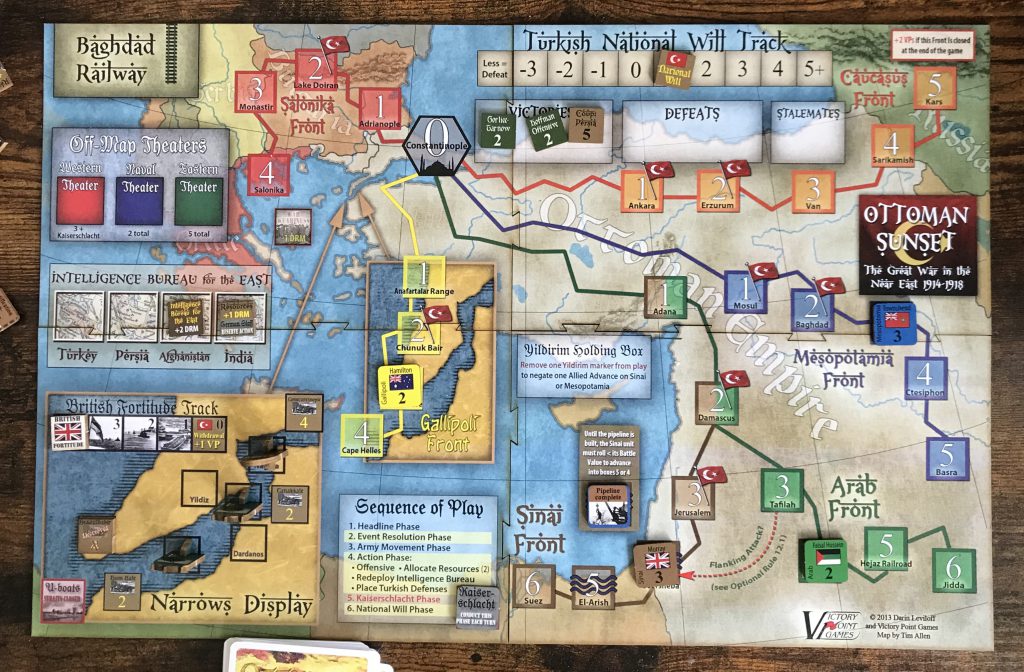
Despite it being a very strategic level game, with fronts abstracted out to a counter you’re fighting with a single D6 roll, it still feels like a wargame. You’re always making choices and attempting to wrest strategic initiative back from your opponent, which makes it feel very much like a wargaming experience. It’s clearly a board game, but the movement of the front counters back and forth across the tracks (the deserts, mountains and canyons) gives it enough of a high-level wargame feel that it satisfies that itch to move your models around. It’s got me wanting to paint a single model for each track too – they’ll just about fit in the box.
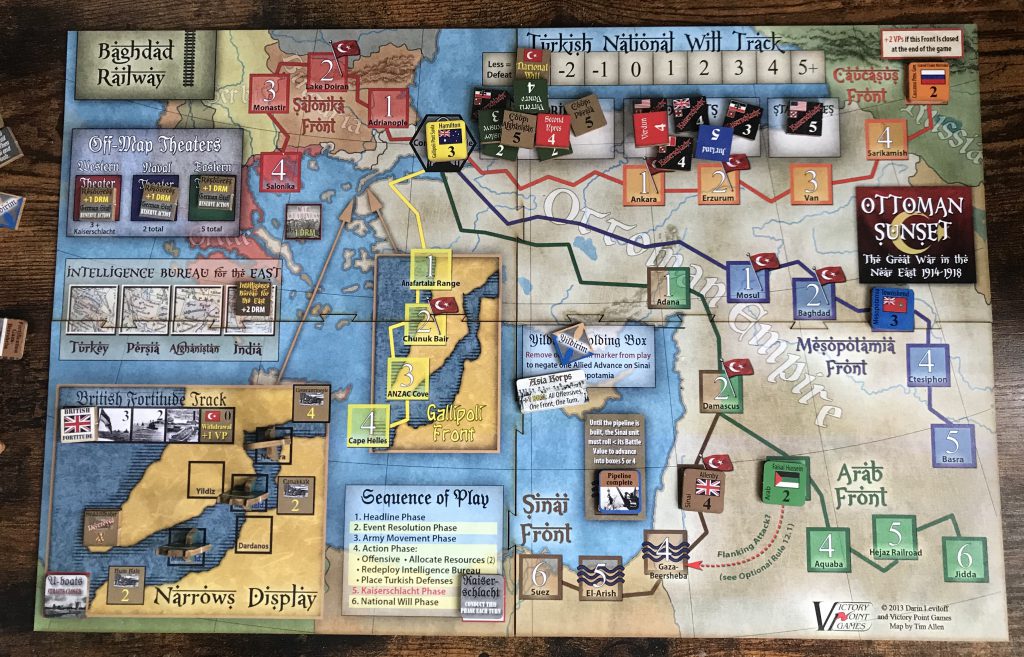
Picking up Ottoman Sunset might be pretty difficult, unfortunately. It doesn’t seem to be on sale from Victory Point anymore, and I’m told this is very much the curse of the Board War Game – short print runs, low stock numbers and niche sales. It’s out there on eBay and second hand sites though if you’re interested – I’d say if you can pick it up or a reasonable price it’s a good addition to a wargamer’s collection.
Got more wargame boardgames to recommend – or want to point out I was tracking National Will incorrectly and could have won a slightly better victory? Drop a note in the comments below or email us at contact@goonhammer.com.


